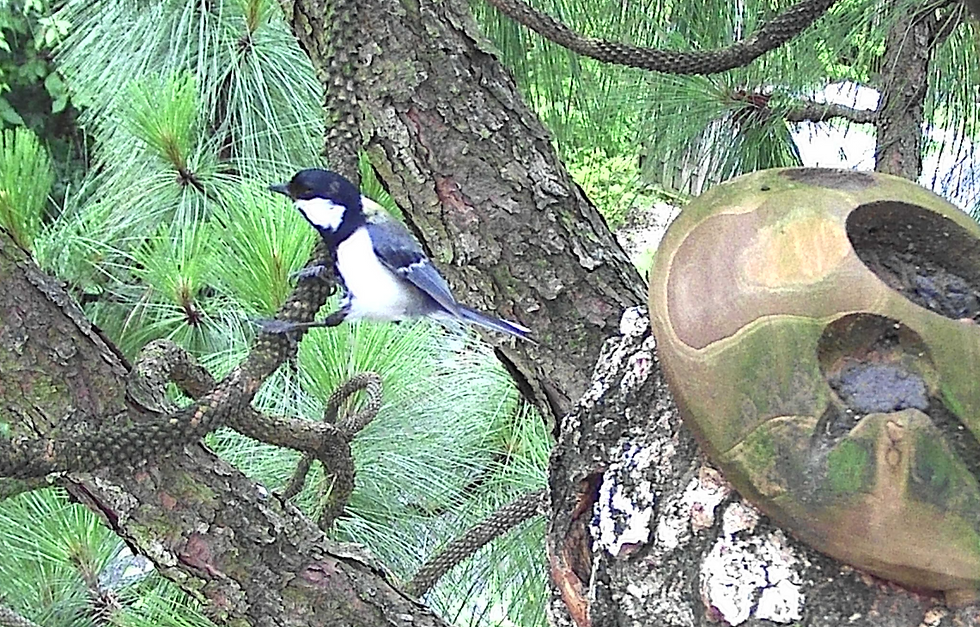Observation Record of Great Tit Breeding in an Artificial Nest Box
- 三重県剪定伐採お庭のお手入れ専門店 剪定屋空

- Sep 14
- 3 min read
(July 12, 2025 – Trail Camera Footage)
On July 13, 2025, a trail camera set up beside an artificial nest box at the exhibition garden “Green & Smile Sanpo-michi” in Suzuka City, Mie Prefecture, captured the breeding behavior of Great Tits (Parus minor).
Only a few days earlier, incubation was confirmed. The footage now revealed that the parents had entered the full-fledged chick-rearing stage.
Location: Sanpo-michi Exhibition Garden, Suzuka City, Mie, Japan
Equipment: Trail camera (Tsukamoto Wireless), Thermography (FLIR)
Target species: Great Tit (Parus minor) – parent and chicks
Scenes from the Trail Camera
Both parent birds were observed repeatedly entering and leaving the nest box.
A visiting sparrow was also briefly recorded near the nest box.

of the Great Tit (Parus minor)
Order/Family: Passeriformes, Paridae
Size: 13–16.5 cm in length, 11–20 g in weight (similar to a sparrow)
Appearance: Greenish back, black head with white cheeks, grayish-blue wings, white underparts with a distinct black “necktie” stripe.
Distribution: Resident bird across East Asia, including Japan and the Russian Far East.
Great Tits thrive not only in forests but also in fragmented green spaces, making them common even in urban environments. They are monogamous, with both parents cooperating in chick-rearing.
They are also known for their complex vocal communication, sometimes described as “bird language,” which serves in warning calls and social interactions.
Diet: Omnivorous—primarily insects, spiders, and seeds.
Breeding: Use natural tree cavities or nest boxes.

Ecological Role and Biological Pest Control
Despite weighing only around 15 g, the Great Tit is a voracious insect eater.
German study (classic data):
One Great Tit consumes approx. 125,000 caterpillars per year.
About 340 insects per day on average.
During breeding season: several hundred leaf-eating insects daily.
Japanese study (fall webworm Hyphantria cunea):
Out of 4,287 eggs laid, only 7 moths reached adulthood, due to heavy predation.
This indicates a >99.8% reduction rate.
Thus, Great Tits play an essential role in natural pest control, reducing the need for chemical pesticides.
Thermal Imaging Finding
s
Thermal imaging with FLIR equipment confirmed how much cooler the inside of the tree cavity was, demonstrating the microclimatic benefits of natural and artificial nest sites.



Nest Box Update
On July 13, nine eggs were confirmed inside the “Acorn Cap Nest Box”, which was handcrafted from pruned trees by Sentei-ya Sora and treated with natural persimmon tannin for preservation.
Breeding cycle (general):
Nest building: Late March–early April, built by female over ~1 week using moss, wool, animal hair, etc.
Egg laying: Mid-April onward, usually 8–10 eggs.
Incubation: Begins only after the last egg is laid; lasts 13–14 days.
Hatching: Nearly simultaneous, within 1–2 days.
Fledging: 18–20 days post-hatching. Juveniles remain with parents for another 2–4 weeks.

Looking Ahead
It is a great joy that wild Great Tits have chosen to nest and raise chicks in a box crafted from our upcycled natural resources.
Future plans include:
Continued monitoring with trail cameras.
Considering a nest box with a built-in camera for closer observation.
Post-breeding analysis of nesting materials and usage patterns.
Creating safe habitats for wild birds not only supports their survival but also contributes to insect population control, environmental education, and regional ecosystem restoration.
At Sentei-ya Sora, we remain committed to bringing out the regenerative power of gardens where life circulates.







